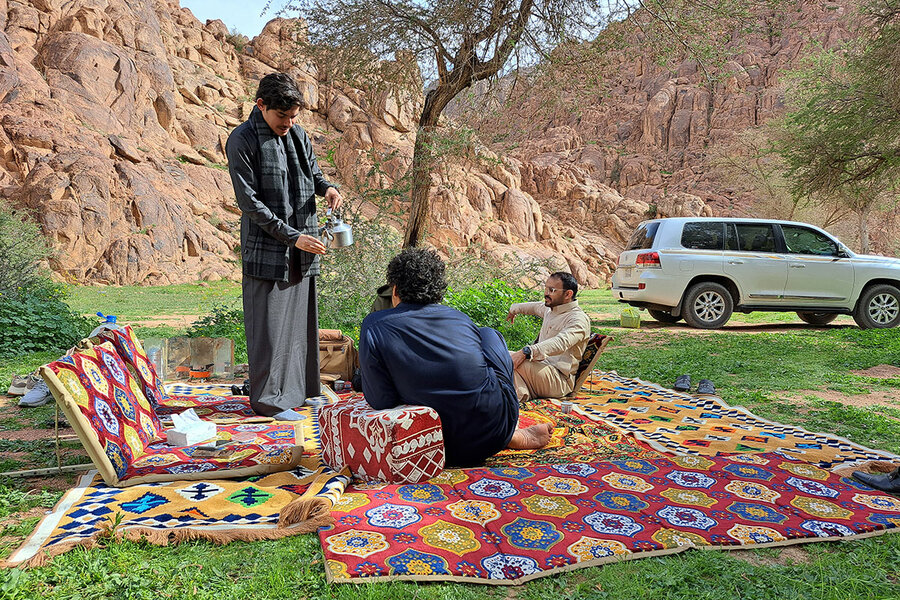Green spring in Saudi Arabia? It’s the season of the grass-hoppers.
Loading...
| HAIL, Saudi Arabia
The images took Saudi Twitter by storm: Thousands of purple wall rocket flowers poke from the rocks; bright new green grass sprouts from the red sands below like some mystical ocean. “If you go to the north,” a Riyadh resident says, holding up the image on his phone, “you have got to find this place.”
It’s springtime in the Saudi desert, and the clock is ticking. Well-timed winter rains have created spring wonderlands that last just a couple weeks. As soon as the grass sprouts, the grass-hoppers are off: grabbing cushions, polishing coffeepots, checking GPS coordinates, and loading the car in a rush for a picture-perfect area to lay down their blankets and start up the grill.
Why We Wrote This
A story focused onHow far would you go for a picnic? In Saudi Arabia, for travelers from near and far, rare desert blooms after perfectly timed winter rains offer much-needed greenery, tranquility, and joy.
“Everyone is coming here looking for this one spot to enjoy the spring,” ranger Hamoud al-Jameel says with a smile at the King Salman Nature Reserve, hundreds of miles from Riyadh, “but there are hundreds more they don’t even know about.”
“Just one day here and all the stress from the city dissipates,” says Riyadh resident Mohammed, who drove six hours from dusty and dry Riyadh to spend four days here. “Being among trees and grass is therapeutic. It relaxes your mind and body.”
As soon as the grass sprouts, the grass-hoppers are off: grabbing the cushions, polishing the coffeepots, checking the GPS coordinates, and starting up the car.
It’s springtime in the Saudi desert, and the clock is ticking.
This year, timely winter rains are leading to desert blooms across the kingdom, transforming patches of arid landscape into spring wonderlands that last just a couple of weeks.
Why We Wrote This
A story focused onHow far would you go for a picnic? In Saudi Arabia, for travelers from near and far, rare desert blooms after perfectly timed winter rains offer much-needed greenery, tranquility, and joy.
These oases of color offer a rare green respite that delights Saudi city-dwellers and people flocking here from Arab states around the Gulf.
For these grass-hoppers starved of greenery – often referred to in Saudi Arabia as “greenery tourists” – a picnic amid these fleeting desert blooms is more than an outing. It’s therapy for the soul.
Driving from his native Qatar, Fahed al-Muri, accompanied by cousins and friends, crossed 750 miles to picnic on Hail’s grass.
“Springtime greenery like this is a rare beauty for us,” says Mr. Muri, motioning from the driver-side window of his 4x4 to the hills of green sands beyond.
“It won’t last long. We have to catch it to enjoy it.”
Viral spring
The images took Saudi Twitter by storm: Thousands of purple wall rocket flowers poke from the rocks, a velvet blanket enveloping the black mountains; bright new green grass sprouts from the red sands below like some mystical ocean.
“If you go to the north,” a Riyadh resident says, holding up the image on his phone, “you have got to find this place.”
On a Friday in mid-February, two dozen SUVs and 4x4s crisscross these very mountains in the King Salman Nature Reserve, kicking up dust clouds as families search for a picture-perfect area to lay down their blankets and start up the grill.
“Everyone is coming here looking for this one spot to enjoy the spring,” reserve ranger Hamoud al-Jameel says with a smile, “but there are hundreds more they don’t even know about.”
While many arid sites in Saudi Arabia are witnessing green blooms this winter, perhaps none are as dramatic as those here in the Hail region. The collection of black and red rocky mountains, deep orange sands, and hidden palm-lined valleys 385 miles northwest of Riyadh lies at the edge of the northern Saudi desert, which stretches on another 435 miles into Jordan.
Here fertile soil and cooler winter temperatures allow green vegetation and flowery blossoms to burst to life – if the rains come just right.
And 2023 is one of those years. Thousands of people from across the region are rejoicing in it.
“The topography here is different. It is greener, there are mountains, valleys, springs,” says Dari – he gave only his first name – who flew into Hail directly from Kuwait City with his friends to experience the spring they saw on social media.
“We are all looking for a nice place just to sit and enjoy the spring outdoors before the long summer months and heat.”
Caravan from Qatar
Mr. Muri and his crew made the trip from Qatar in two SUVs. Along the way across Saudi Arabia they hopped from green patch to green patch, camping in spots they’d seen on social media: Qassim, Hafr al Butn, and finally Hail.
“This is the best place to experience spring in the Gulf, and the locals are hospitable, driving up was a no-brainer,” says Mr. Muri. “By the way,” he asks Mr. Jameel, the park ranger, “do you know of a really good green spot?”
Soon they are following the ranger deeper into the reserve, swerving between acacia trees and dipping down and up from ravines, in search of the perfect oasis for the night.
After a left turn, the wide expanse narrows into a secluded valley nestled between pink rocks, lined for more than a mile with 20-foot-tall trees creating a rare canopy over the thick grass.
As they set up camp half a mile away, Riyadh residents Mohammed and his friends sip black tea and lounge on a colorful camping carpet spread over a particularly thick circle of grass behind jagged rock formations.
The night before they had driven six hours from dusty and dry Riyadh to spend four days away from the capital’s beige urban landscape.
“Just one day here and all the stress from the city dissipates,” Mohammed says, leaning against a pillow. “Being among trees and grass is therapeutic. It relaxes your mind and body.”
“Being in the green outdoors is a spiritual refresher,” his friend says as he snaps photos of a flower a few feet from their blanket. “It feels like it strengthens your soul.”
The rain’s timing is everything
But not all winters yield green springs.
The timing of winter rainfall is a critical factor for desert blooms. If the rains come too early, the grass will not grow; too late, and the shrubs and grass will burn in the April heat.
Gulf nationals monitor rainfall carefully. As December saw good rains in Saudi Arabia, they knew that a February bloom was likely in store.
“We knew there were good rains this winter and that we should plan a camping trip to Saudi Arabia,” says Dari, the Kuwaiti camper. “Once we saw the photos circulate, we booked.”
In downtown Hail, Nayef al-Kaim’s store is buzzing; several out-of-towners browse this one-stop shop for picnicking and camping needs, one of several in town.
Camping is a regular pastime for Saudis, but this is prime time.
Winter is Mr. Kaim’s high season. In addition to locals and hunters, dozens of visitors from across Saudi Arabia and the Gulf come each day and browse the oriental-carpet-patterned insulated blankets, carpeted mats, tents, sleeping bags, lights, grills, and – for those going further afield in their pursuit of the perfect patch of grass – walkie-talkies and GPS devices.
“Camping is in our roots and our genes,” Mr. Kaim says as he attends to a customer feeling the thickness of a sleeping bag with his hands. “Bedouins are the original green tourists.”
Some of those original green tourists are out and about: Camel and sheep herders in sputtering pickup trucks across the kingdom are looking for long stretches of green pasture, seeking to take advantage of the few weeks out of the year in which their livestock can eat for free.
“Just like in the days of our forefathers, spring is a blessing,” Mr. Kaim says. “And all of us – humans and animals – must savor it before it disappears.”











